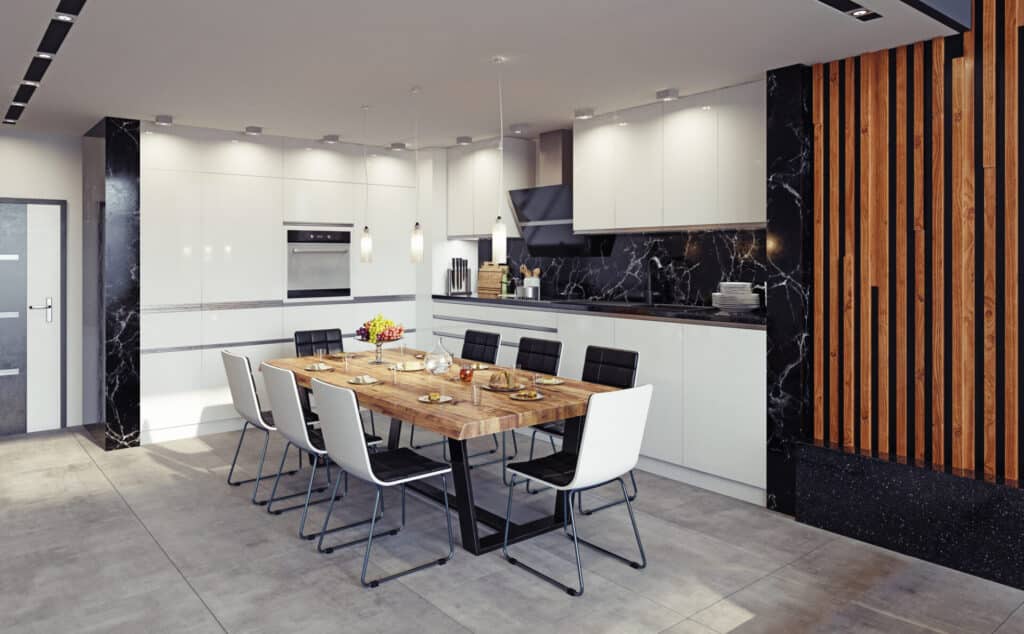
Lighting is a crucial element in any kitchen design. Not only does it provide illumination for cooking and food preparation, but it also sets the mood and enhances the overall aesthetic appeal of the space. With a vast array of light fixtures available on the market, choosing the right ones when doing kitchen remodeling can be a daunting task. To help you make an informed decision, this article will guide you through the process of selecting the best light fixtures for your kitchen.
Consider the Overall Style of Your Kitchen
Before diving into the specifics of light fixtures, it is important to consider the overall style and design of your kitchen. Are you aiming for a modern, sleek design or a more traditional and rustic look? The style of your kitchen will control the type of light fixtures that will best complement the space.
For modern kitchens, you may want to opt for clean and minimalist fixtures. Look for fixtures with sleek lines and a contemporary finish like brushed nickel or chrome. Pendant lights with geometric shapes or a cluster of simple glass globes can add a touch of elegance to a modern kitchen.
Conversely, if your kitchen has a more traditional or rustic style, consider fixtures that have a vintage or weathered look. Chandeliers with ornate details or lantern-style pendants can enhance the charm and character of a traditional kitchen. You could also explore fixtures made from materials like wrought iron or hand-blown glass to achieve a rustic ambiance.
Understand the Different Types of Kitchen Lighting
To ensure proper illumination when doing home kitchen remodeling, it is important to understand the different types of lighting that can be used. Combining these various types of lighting will allow you to create a well-lit and functional space.
Ambient Lighting: This is the general lighting that provides overall illumination for the entire kitchen. It is typically achieved through ceiling-mounted fixtures such as flush mounts or recessed lights. Ambient lighting should be evenly distributed to eliminate shadows and create a bright and inviting atmosphere.
Task Lighting: As the name suggests, task lighting is focused on specific areas where tasks such as food preparation, cooking, and reading recipes are performed. Under-cabinet lighting is a well-liked choice for task lighting in the kitchen. It can be placed underneath cabinets to provide direct lighting on countertops or workspaces. Pendant lights or track lighting can also be used to illuminate specific task areas.
Accent Lighting: Accent lighting is used to highlight architectural features, decorative objects, or focal points in the kitchen. It adds depth and visual interest. You can achieve accent lighting through the use of adjustable recessed lights, track lighting, or even wall sconces. It is a great way to showcase artwork, a unique backsplash, or open shelving.
Consider the Size and Layout of Your Kitchen
The size and layout of your kitchen should also be taken into consideration when choosing light fixtures. A smaller kitchen may benefit from smaller, more discreet fixtures to avoid overwhelming the space. Recessed lights or flush mounts can blend seamlessly into the ceiling, providing an unobtrusive lighting solution.
On the other hand, larger kitchens with higher ceilings can accommodate larger fixtures that make a statement. Chandeliers or pendant lights with multiple bulbs can be used to fill the vertical space and create a focal point. However, always ensure that the scale of the fixture is appropriate for the size of the room, as an overly large fixture may look out of place.
Additionally, consider the layout and functionality of your kitchen. If you have a kitchen island, pendant lights can be a great choice to provide both task lighting and visual appeal. Hang the lights at a height that doesn’t obstruct the line of sight or interfere with daily activities. In an open-plan kitchen, where the kitchen flows into the living or dining area, it is important to choose light fixtures that go mostly with the design and create a cohesive look.
Determine the Light Fixture Placements
Deciding where to place your light fixtures is just as essential as selecting the fixtures themselves. Proper placement ensures the right amount of light in the appropriate areas. Consider the following guidelines for fixture placement:
- For ambient lighting, ensure that the fixtures are evenly dispersed throughout the kitchen to eliminate dark corners and shadows. Recessed lights placed approximately 4 to 6 feet apart can achieve a balanced distribution. If using a central ceiling fixture, make sure it provides ample coverage for the entire space.
- Task lighting should be strategically placed in areas where specific tasks are performed. Install under-cabinet lighting to illuminate countertops and workspaces. Position pendant lights above islands or peninsulas to provide direct lighting for meal preparation or dining.
- Accent lighting should be used to highlight architectural features, decorative objects, or focal points. Place adjustable recessed lights or track lighting to create points of interest in your kitchen. Consider wall sconces to highlight artwork or open shelving.
Don’t Forget About Energy Efficiency
In today’s environmentally-conscious world, energy efficiency is an important factor to consider when selecting light fixtures. Opting for energy-efficient fixtures not only lowers your carbon footprint but also saves you money on electricity bills in the long run.
LED (Light Emitting Diode) lights have gained popularity in recent years due to their energy efficiency and long lifespan. They are available in various color temperatures, allowing you to choose between warm or cool lighting. Consumption from LED lights consumes less energy compared to incandescent bulbs, making them the popular choice for both task and ambient lighting.
Another energy-efficient option is compact fluorescent lights (CFLs). While not as popular as LED lights, CFLs can still provide a significant energy-saving alternative. CFL bulbs are typically spiral-shaped and come in various color temperatures. They have a longer lifespan compared to incandescent bulbs and are much more energy-efficient.
Ensure Proper Light Intensity and Color
Aside from the type of light fixtures, it is crucial to consider the light intensity and color temperature. Different activities in the kitchen require different levels of lighting, so it is important to choose fixtures with the appropriate brightness. Fixture brightness is typically measured in lumens, so make sure to check the packaging for the lumen rating.
For ambient lighting, aim for a bright, well-lit space. A good starting point is to have approximately 20-30 lumens per square foot of kitchen space. For task lighting, especially in food preparation areas, opt for higher levels of brightness. Aim for around 50-75 lumens per square foot to ensure ample lighting for precise tasks.
In addition to light intensity, the color temperature of the light can dramatically affect the overall feel of your kitchen. Light color temperature is measured in Kelvin (K) and is commonly categorized into warm, neutral, and cool lighting.
Warm lighting, typically around 2700-3000K, creates a cozy and inviting ambiance. It replicates the warm glow of incandescent bulbs and is often used in traditional or rustic kitchens.
Neutral lighting, around 3500-4000K, is a balanced option that works well in most kitchens. It provides a natural white light that is neither too warm nor too cool.
Cool lighting, around 5000-6500K, emits a bright, bluish-white light. It is often used in contemporary kitchens or spaces where bright lighting is necessary, such as commercial kitchens.
Consider Lighting Controls and Dimmers
To enhance the functionality and flexibility of your kitchen lighting, consider incorporating lighting controls and dimmers into your design. These allow you to adjust the brightness and mood of your kitchen as needed.
Dimmers are particularly useful as they allow you to control the intensity of your fixtures. This is especially important for ambient lighting, as it provides the flexibility to adjust the brightness based on different activities and occasions. Lowering the lighting level can create a more intimate atmosphere during evening gatherings while increasing it ensures optimal visibility during meal preparation.
If you have multiple light sources in your kitchen, consider installing separate switches or controls for different areas. This allows you to customize the lighting in each zone according to your specific needs.
Shop Around and Seek Professional Advice
Once you have a clear idea of the style, type, placement, and energy efficiency of the light fixtures you require, it’s time to start shopping around. Visit lighting stores, both physical and online, to explore a wide variety of options. Take note of the dimensions, specifications, and compatibility of each fixture to ensure they will work well in your kitchen.
While shopping, don’t hesitate to seek professional advice. Lighting experts or kitchen remodeling contractors can provide valuable insights and suggest specific fixtures that suit your needs. They can guide you through the technical aspects, help you visualize how the fixtures will look in your kitchen, and ensure you make an informed decision.
In conclusion, choosing the best light fixtures for your kitchen is a process that requires careful consideration of the overall style, type, placement, energy efficiency, and functionality. By understanding the different types of lighting, considering the size and layout of your kitchen, and paying attention to light intensity and color, you can create a well-lit and visually appealing kitchen. Don’t forget to shop around, seek professional advice, and, most importantly, trust your instincts and personal preferences. With the right light fixtures, your kitchen can become a functional and aesthetically pleasing space that you and your loved ones will enjoy for years to come.
